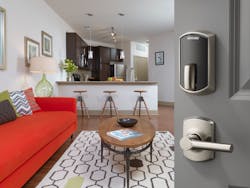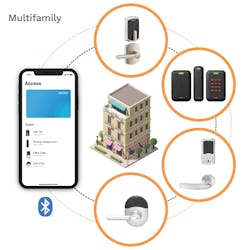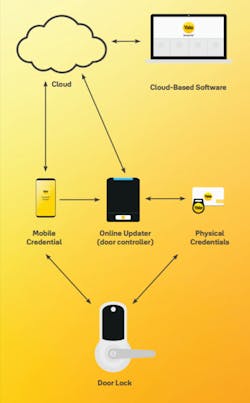If you speak about business with anyone at a manufacturer of security products in 2022, you likely will hear a lot about the multifamily market. That should be good news for security pros, because that’s likely to mean more opportunities to participate in what can be a lucrative business.
Glenn Younger, president of Grah Lock & Safe in San Diego, says the nature of multifamily makes it particularly attractive to security pros.
“If there’s a goose that lays the golden egg in our industry, it’s having customers that have a lot of doors in a fairly small area,” he says. “That’s what everybody is looking for.”
The reason is obvious — lots of potential work in little space, thus leading to less travel (and fewer expenses) from one job to the next. And what type of customers have those multiples of doors in small spaces? Commercial offices, sure, but also high-rise or sprawling garden-style apartment complexes — in other words, multifamily housing.
Younger adds that although most people think of the latter two when they think of multifamily housing, multifamily housing means more than just apartment and condominium complexes.
“Student housing is a great example,” he says, providing one example of a multitenant building that might not traditionally be thought of as multifamily housing. Further examples: senior living, military housing, vacation rentals (think: Airbnb or VRBO).
“On 5 acres, they may have 500 doors,” he points out. You don’t have to move your service vehicle far or even at all to service all those doors. “Man, that’s golden.”
Are You Experienced?
However, there’s some bad news for locksmiths who remain mechanical holdouts: Multifamily continues to move firmly into the electronic camp.
This is because of a younger population that has grown up with smartphones. They want more of what manufacturers call “experiences” that they connect with through their smartphone or other smart device.
That means that as a more tech-savvy population moves into apartments and other types of multitenant housing, they want the doors and, thus, the locks they use to be part of that “experience.”
“Now, residents expect their lock and the ways they get in it to be a part of a much broader building and apartment ecosystem,” says Bryan Lieberman, director of business development for multifamily solutions at ASSA ABLOY. “For instance, residents expect that the same way they get into the perimeter of a building, like a parking garage, main entrance or gate, to be the same as the way they get into their apartment door.”
Residents also want to be able to grant access to those various openings to certain guests, such as family or friends, a dog walker or a package- or food-delivery person, without having to contact management or cut another set of keys, Lieberman adds. Then, there’s the property owner or manager who wants to be able to make changes quickly when residents move in and out while also being able to track who comes and goes and how frequently.
The Lock Isn’t the Key
How one accomplishes all of this is obvious — through smart locks that are tied to a central access control and management system. However, the message that manufacturers increasingly provide today with respect to their multifamily solutions isn’t so much the lock but the system behind the lock.
To be sure, the lock is fundamental. Every manufacturer who is invested or interested in the multifamily market says any property has to have the best possible locking devices on every door and that those locks must work at all times, but the innovation in the market increasingly is happening on the software side.
In fact, Preston Grutzmacher, the residential business leader in North America for SALTO Systems, says properties should choose the access control platform first — in other words, the software.
Although Lieberman says the quality of the hardware and software are of equal importance, he acknowledges that the lock itself has become more commoditized. “What differentiates hardware is the technology flexibility it offers and how you access it,” he says. “Product selection can no longer be made based on hardware alone.”
Recent changes to smart locks used in the multifamily market generally aren’t to the lock itself but in the information received. In fact, today’s smart locks are increasingly “dumb” in the sense that as far as passing information back and forth from the computer server or, increasingly, the cloud, the lock does less of the work compared with the credential itself. A “dumber” smart lock can be more flexible, because it can provide new information and work with different systems as demands change without requiring a new lock to be installed.
“The mobile credential has made the offline lock [have] a lot of the same features as an online lock.” Gaulden says.
Consequently, when it comes to innovations in multifamily, it’s all about new services. Lieberman points out four that other manufacturers also acknowledge:
- Resident-delegated access, or the ability to grant access without contacting management, while on the premises or remotely
- Integrated package-delivery systems
- Integrated smart-home features, such as a thermostat
- Unguided or self-guided tours of a facility
“Self-guided tour is probably the No. 1 thing I hear about today,” Gaulden says. He describes it as allowing a prospective resident to gain access to an empty unit, visit the pool or other amenities and perhaps even sign a lease through an app. “‘I liken this to a test drive, someone just flipping you the keys and saying, ‘I’ll see you in about 30 minutes. Let me know what you think about the experience.’”
Employing the Shift
Younger has noticed this shift to a more-software-centric multifamily market. Previously, he believed that as long as the software accomplished a few basic tasks, the hardware was the most important consideration. Now, although he contends that the lock still must be of sufficient quality — and manufacturers agree — he isn’t as sure.
So what does that mean to the security pro who has worked or wants to work in the multifamily arena? In addition to having to know their hardware and how to install it, they’ll have to become educated on the software side, both in terms of product selection and set up, to advise their customers as well as perform any necessary service.
“Our guys are scared every time we get thrown a new system,” he says. He notes that Grah recently started to work with locks powered by RemoteLock, which provides the brains behind a number of smart locks. “Even my guys who are pretty good with software were like, ‘oh gosh, it’s new software,’ and that’s scary, just because it’s new.”
To get past that takes two things. One is simple familiarity, and Younger compares working with multifamily software with using a smartphone. The hardware — the phone — often requires software updates, whether that’s an operating system or an app, and we’ve become used to making those updates and setting up new functionalities, often through trial and error.
“[Multifamily access control] software is the same way,” he says. “You know, a lot of times it’s simple and easy enough that once you’ve set up five different kinds of software for five different kinds of access control systems, you might say, ‘Oh yeah. They typically do this.’ You see patterns and can deal with it.”
Of course, security software is moving increasingly to the cloud and thus accessible through that same smartphone, which brings an additional element of familiarity to it, at least with entry-level systems that provide audit trail capability or remote access.
The other way to get past the intimidation of working with new software, or software at all, is to call on the experts — manufacturers and distributors.
“A lot of security pros don't like to rely on factory tech support, and I get it, because sometimes they can’t get them and they’re not great,” Younger says. “But this is a case where you need to. You need to say, ‘I need to talk to somebody who knows more about this software than I do.’”
Get Smart
How to become well-versed in multifamily software goes back to a staple of basic locksmith business operation — research. That’s research discovered through educating yourself about the differences among manufacturer products and, more important, finding out what the customer wants to accomplish.
Lieberman provides a series of “better questions” security pros should ask of their multifamily clients instead of just how do you want these doors to be locked:
- How do you want your residents to access their apartment: via a card, fob, PIN code or phone?
- Do you want them to be able to lock and unlock remotely or locally only?
- Does only on-site staff make access management decisions, or are some decisions made off-site?
- Do you want other systems, such as HVAC, elevator access, perimeter access or parking, to be managed from the same system that controls the apartment locks?
Locksmiths have “to be aware about how the answers to these questions may bear on both the hardware and software decisions,” he says, because not all locks can enable features in a particular software and vice versa.
One feature that everyone agrees on is that the software has to be easy to use — “intuitive” is the often-used term. Gaulden likens it to a great lock that’s difficult to install. The result of such a lock is locksmiths won’t recommend that lock.
“If the training in the software is just mind-boggling and not intuitive, turnover in the front office is every six months, you’re going to have to be out there retraining the staff over and over and over again,” he says. “That’s going to cost the locksmith quite a bit of money.”
The good news is improved ease of use is something everyone continues to work on, so just as manufacturers look to make their locking solutions easier to install, so do they with the software that drives those locks.
And keep in mind that software that has advanced capabilities doesn’t necessarily require the use of all of those features out of the box. Again, it all depends on the “experience” that the property manager wants to set up for the resident, which is why it’s important to ask what the goal is of the security system.
Gaulden says starting with basic access control and remote management might be more than enough for a multifamily property. The key is that advanced capabilities are possible later with minimal effort.
“It’s kind of like, you have to jump in the water if you want to learn how to swim,” Younger says. “You have to jump in the pool if you want to learn how to do multifamily-housing locks.”
Below are a few multifamily locks and software systems that begin that process and let you eventually move to the deep end of the pool:
SALTO XS4 / Space / KS
The XS4 family of smart locks provides a wide range of options to all types of multifamily doors, including lockers at a gym or a deadlatch for mixed-use multifamily high-rises. The locks are compatible with ANSI-standard cylindrical and mortise locks and include Grade 1 and Grade 2 certified models.
They’re also compatible with both of SALTO’s software platforms, Space, which requires a server on the premises, and KS, which is cloud-based.
Grutzmacher says that although the trend for software is to move it to the cloud, providing both options creates more flexibility for property owners and managers depending on their budget demands. Security pros also benefit one way or the other.
On-site software “offers additional potential service agreements and revenue streams” to security pros, he says. Cloud software, however, allows them to monitor multiple sites without having to visit each site. “It makes it easier for a security pro to be proactive rather than reactive to potential service issues.”
The different platforms have much of the same functionality, although they might accomplish the tasks differently. One new facet of Space allows for the use of SALTO’s JustIN mobile app, which can be stored in Apple wallet and thus used to unlock a lock without the app being open.
As for the door locks, they come in a range of finishes and have a range of lever options. They also handle a wide range of door sizes, from 1-3/8 inches up to 4-3/4 inches, depending on the model. The recently upgraded XS4 Original+ allows for single-action egress.
More info: saltosystems.com/en-us
Schlage Control / ENGAGE
The Control series of locks by Allegion brand Schlage is the company’s current line of locks aimed at the multifamily housing line. It comes in ANSI/BHMA Grade 2 deadbolt or interconnected locks for single-motion egress and has Bluetooth Low Energy (BLE) mobile-credential capability built in.
On the software side, ENGAGE cloud-based mobile or web apps allow property managers to manage lock access remotely while receiving use data and alerts. Control locks also can be integrated with third-party system providers, such as Lenel, for advanced functionality.
A notable feature, particularly on newer construction, is the Control’s 1-inch manual-throw deadbolt. This is a benefit to the property owner as well as the locksmith, Gaulden notes. For the property owner, the manual-throw deadbolt keeps any liability on the resident, while an auto-throw deadbolt that doesn’t lock places liability on the property owner. For the locksmith, manual-throw means a dearth of repeated service calls as the building settles.
“If you have an auto-throw lock and a wood-frame building and it’s less than 6 years old, I’m going to guarantee you, a lot of your locksmiths will not want to install that one again, because they will just be running out there shimming and servicing deadbolts that are not locking,” he says.
Control locks fit a 1-3/4-inch door, with thick-door kits available, and have an adjustable 2-3/8–2-3/4-inch backset. Multiples trims styles and finishes are available.
More info: us.allegion.com
Yale nexTouch / Accentra
The nexTouch line of smart locks is designed for flexibility. In addition to coming in cylindrical, sectional mortise and exit trim versions, they also can be hard-wired as well as battery-powered, depending on demand.
The ANSI/BHMA Grade 1 locks can shift from stand-alone keypad operation via the locks’ capacitive touchscreen to data-on-card and wireless integration with Accentra apps and third-party access control systems through their modular design. You just swap out one lock module for another as necessary.
“If you choose to switch software providers or technologies as your needs change, you can do so without needing to change out your hardware,” Lieberman says.
As for the Accentra software behind the lock, a new easier cloud-based interface has been added. Physical credentials, such as a card or fob, can be updated automatically through close passage to an online updater, and mobile credentials, which recently were added to the locks’ capability, can be updated remotely and enabled at the lock. Accentra also works with Grade 2 Yale Assure deadbolts and interconnected locks for more flexibility.
The nexTouch locks fit standard doors from 1-3/8 inches to 2-1/4 inches, depending on the model, and all allow for a variety of key-override cylinder options, including small-format interchangeable core. The exit trim’s adjustable mounting posts allow it to be compatible with many brands of exit device.
More info: www.yalecommercial.com
About the Author
Will Christensen
Senior Editor
Will Christensen is senior editor at Locksmith Ledger International. He has been an editor and reporter at magazines and newspapers for more than 30 years.



